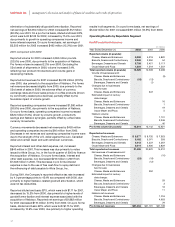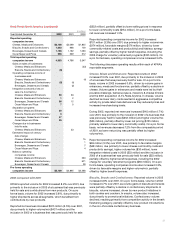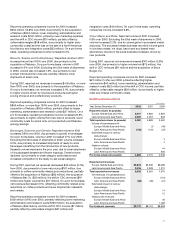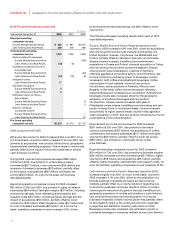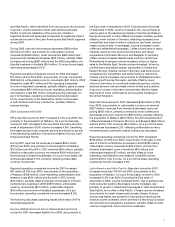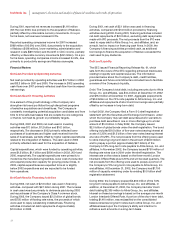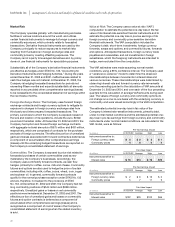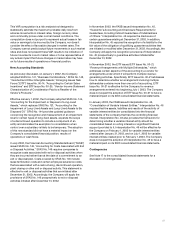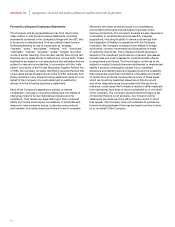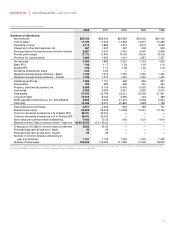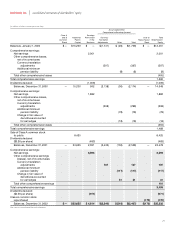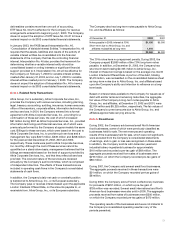Kraft 2002 Annual Report Download - page 45
Download and view the complete annual report
Please find page 45 of the 2002 Kraft annual report below. You can navigate through the pages in the report by either clicking on the pages listed below, or by using the keyword search tool below to find specific information within the annual report.
This VAR computation is a risk analysis tool designed to
statistically estimate the maximum probable daily loss from
adverse movements in interest rates, foreign currency rates
and commodity prices under normal market conditions. The
computation does not purport to represent actual losses in fair
value or earnings to be incurred by the Company, nor does it
consider the effect of favorable changes in market rates. The
Company cannot predict actual future movements in such market
rates and does not present these VAR results to be indicative of
future movements in such market rates or to be representative of
any actual impact that future changes in market rates may have
on its future results of operations or financial position.
New Accounting Standards
As previously discussed, on January 1, 2002, the Company
adopted SFAS No. 141, “Business Combinations,” SFAS No. 142,
“Goodwill and Other Intangible Assets,” Emerging Issues Task
Force (“EITF”) Issue No. 00-14, “Accounting for Certain Sales
Incentives” and EITF Issue No. 00-25, “Vendor Income Statement
Characterization of Consideration Paid to a Reseller of the
Vendor’s Products.”
Effective January 1, 2002, the Company adopted SFAS No. 144,
“Accounting for the Impairment or Disposal of Long-Lived
Assets,” which replaces SFAS No. 121, “Accounting for the
Impairment of Long-Lived Assets and Long-Lived Assets to Be
Disposed Of.” SFAS No. 144 provides updated guidance
concerning the recognition and measurement of an impairment
loss for certain types of long-lived assets, expands the scope
of a discontinued operation to include a component of an
entity and eliminates the exemption to consolidation when
control over a subsidiary is likely to be temporary. The adoption
of this new standard did not have a material impact on the
Company’s consolidated financial position, results of
operations or cash flows.
In July 2002, the Financial Accounting Standards Board (“FASB”)
issued SFAS No. 146, “Accounting for Costs Associated with Exit
or Disposal Activities.” SFAS No. 146 requires companies to
recognize costs associated with exit or disposal activities when
they are incurred rather than at the date of a commitment to an
exit or disposal plan. Costs covered by SFAS No. 146 include
lease termination costs and certain employee severance costs
that are associated with a restructuring, discontinued operation,
plant closing or other exit or disposal activity. This statement is
effective for exit or disposal activities that are initiated after
December 31, 2002. Accordingly, the Company will apply the
provisions of SFAS No. 146 prospectively to exit or disposal
activities initiated after December 31, 2002.
In November 2002, the FASB issued Interpretation No. 45,
“Guarantor’s Accounting and Disclosure Requirements for
Guarantees, Including Indirect Guarantees of Indebtedness
of Others.” Interpretation No. 45 requires the disclosure of
certain guarantees existing at December 31, 2002. In addition,
Interpretation No. 45 requires the recognition of a liability for the
fair value of the obligation of qualifying guarantee activities that
are initiated or modified after December 31, 2002. Accordingly, the
Company will apply the recognition provisions of Interpretation
No. 45 prospectively to guarantee activities initiated after
December 31, 2002.
In November 2002, the EITF issued EITF Issue No. 00-21,
“Revenue Arrangements with Multiple Deliverables,” which
addresses certain aspects of the accounting by a vendor for
arrangements under which it will perform multiple revenue-
generating activities. Specifically, EITF Issue No. 00-21 addresses
how to determine whether an arrangement involving multiple
deliverables contains more than one unit of accounting. EITF
Issue No. 00-21 is effective for the Company for revenue
arrangements entered into beginning July 1, 2003. The Company
does not expect the adoption of EITF Issue No. 00-21 to have a
material impact on its 2003 consolidated financial statements.
In January 2003, the FASB issued Interpretation No. 46,
“Consolidation of Variable Interest Entities.” Interpretation No. 46
requires that the assets, liabilities and results of the activity of
variable interest entities be consolidated into the financial
statements of the company that has the controlling financial
interest. Interpretation No. 46 also provides the framework for
determining whether a variable interest entity should be
consolidated based on voting interests or significant financial
support provided to it. Interpretation No. 46 will be effective for
the Company on February 1, 2003 for variable interest entities
created after January 31, 2003, and on July 1, 2003 for variable
interest entities created prior to February 1, 2003. The Company
does not expect the adoption of Interpretation No. 46 to have a
material impact on its 2003 consolidated financial statements.
Contingencies
See Note 17 to the consolidated financial statements for a
discussion of contingencies.
41



